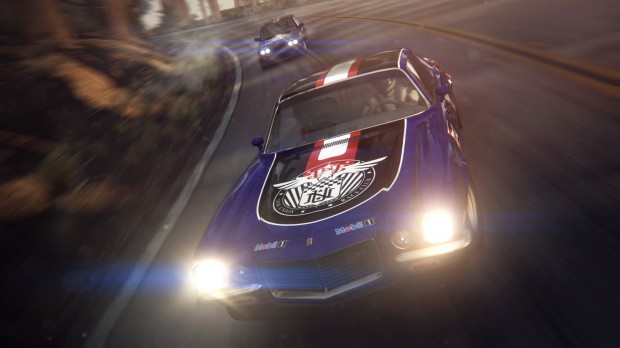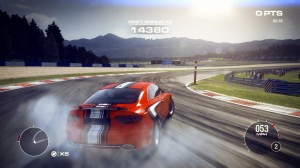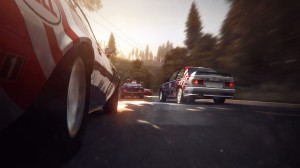Hands-on with GRID 2 Multiplayer
- Updated: 16th Apr, 2013

GRID 2 is going to be social. Very social. GRID 2 has online dating software built into it, only instead of your turn-ons and turn-offs it records your track times and XP level, and instead of a prospective romantic partner you get matched with a rival tailored to your playstyle. I asked Lee Roberts, Senior Games Designer, whether it seemed a bit like a high-octane version of match.com.
“Yeah, well, it is a little, but for cars. It’s a dating service without the kissing and the touching. Unless you really get on. Then kissing and touching might be okay. There’s got to be a little bit of tension there.”
The Rivals
There’s driving, of course, and lots of crashing into things or exciting nearly crashing into things, although when I played the experience veered heavily towards the first option. But the social system is where we can see real change over the formula of Drive Cars Fast.
The Rival system is the most interesting facet of the integration with Racenet (Codemasters’ social gaming platform which is inexplicably not called Racebook); while it’s been possible for years to see how good you are at driving a car really fast around difficult corners when compared to the rest of the world, it can often be a fairly disheartening experience as, odds are, you’re probably nowhere near the best.
The Rivals system puts a much-needed human face on the concept of ongoing challenge by selecting six players you’re competing against on a weekly basis – one automatically derived from your stats, one selected from a series of parameters that you can set and adjust, and four more Social rivals that you can pick out of your online friends. If you like someone chosen for you via the matchmaking service, you can put them into one of your social slots – and if not, well, they’ll just have to deal with the heartbreaking rejection.
Little Celebrity
This, coupled with Followers – social XP, for a lack of a better word – should give players a reason to keep playing GRID 2 long after the hype has worn off. Codemasters are looking to move away from Legacy boards and towards weekly challenges, keeping in sync with a player base that are perpetually connected to the internet and hungry for social interaction with their peers. It’s a smart move.
 “When you go away from the game your followers start to bleed off as well,” Lee continued, “so you may have unlocked all the cars, gained all the experience, bought all the upgrades, but this constant growing fanbase – there’s always something to strive for. So the person who keeps playing, keeps on winning, keeps beating those rivals, is going to be the most famous driver in the GRID 2 universe. We’re going to push those players out there, promote them a bit more, and give them a little celebrity.”
“When you go away from the game your followers start to bleed off as well,” Lee continued, “so you may have unlocked all the cars, gained all the experience, bought all the upgrades, but this constant growing fanbase – there’s always something to strive for. So the person who keeps playing, keeps on winning, keeps beating those rivals, is going to be the most famous driver in the GRID 2 universe. We’re going to push those players out there, promote them a bit more, and give them a little celebrity.”
The multiplayer has been quietly streamlined in general; most notably, players will be matched in races on the basis of their “collision rating,” or “how often they use rival cars as cornering aids.” That way, if you’re looking for the sort of match where your opponents will deliberately smash you into walls, you hopefully won’t end up like a cat amongst the pigeons in a group of racing line enthusiasts. Or vice versa, like a pigeon amongst the cats, I guess.
Liveries are easier to design. Car parts now no longer require extensive retuning to actually improve your car’s performance. A Playlist system lets you choose what sort of races you want to take part in online, whether it’s Race for standard, Alt for non-standard, or All for a grab-bag of everything. The experience looks to have been slanted towards getting players on the road as fast as humanly possible.
“NEVER STOP”
Hands-on against seven other journalists, I’m happy to report that the game is still as fun as ever. Cars screech satisfyingly round corners and collide messily with each other as they jostle for first place; engines are pleasingly meaty and damage is faithfully represented graphically, although you can turn off any physical effects if you’d like. One feature, a computer-calculated penalty that slows you down if you cut a corner and gain an advantage by doing so, seems weirdly out-of-place and breaks the flow of the game, if I’m honest, but at least it’s better than having massive great walls of tyres stuck to the side of every corner a la GRID 1.
 But the most interesting thing yet in the game – even more interesting than the whole online dating thing – is the Live Route System, an algorithm that twists and bends each track around hundreds of possible combinations of angle and length. You won’t be able to learn a track through muscle memory and perfect racing lines, because what might have been a smooth left the last nine times might be a hard right the tenth, and leave you embarrassingly wedged around a lamppost.
But the most interesting thing yet in the game – even more interesting than the whole online dating thing – is the Live Route System, an algorithm that twists and bends each track around hundreds of possible combinations of angle and length. You won’t be able to learn a track through muscle memory and perfect racing lines, because what might have been a smooth left the last nine times might be a hard right the tenth, and leave you embarrassingly wedged around a lamppost.
Graham Bromley, the Lead Level Designer, chipped in: “The way that GRID 1 was set up allowed only a limited number of challenges, so those guys who are still playing today have had to churn and repeat those same experiences. We’re taking that forward. It offers an experience that never stops.”
It’s hard to see whether it works in preview events, of course, because we’ve not had time to see the differences created by the system – but if it does what it promises, it’s a very clever beast indeed. What we’ve got here is a cracking racer that straddles the line between technical and arcade and threatens to “never stop.” That’s a hell of a thing to attempt, and quite what the devs mean by “never” remains to be seen. But it’s a noble goal, for sure.
GRID 2 will be out on 31st May for PC, Xbox 360 and PlayStation 3.

Follow Us!